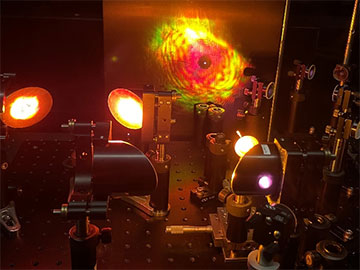
A short-pulsed laser generates a supercontinuum. The creation of a plasma produces light that spans the visible and invisible parts of the electromagnetic spectrum. [Image: Kareem J. Garriga Francis and Xi-Cheng Zhang]
Researchers have been exploring plasma-based sources of high-power terahertz radiation. However, direct measurements of the terahertz field inside plasma filaments have challenged scientists because any detector placed within the plasma would fail.
Recently, two US-based scientists reported directly detecting the terahertz field inside a plasma filament generated by a single shot of a powerful laser (Front. Optoelectron., doi:10.1007/s12200-023-00095-y). The pair exploited a nonlinear optical process called terahertz field-induced second harmonic (TFISH) generation, which they say for the first time produced a signal at wavelengths visible to humans.
Exploring THz detection
Research teams have been studying various options for coherent detection of terahertz signals, including a pump-probe technique called electro-optic sampling within nonlinear crystals. However, resonances within the crystals and other issues hamper the effective detection of terahertz rays. Past experiments with TFISH required several shots of a high-power laser, but scientists would prefer to conduct the measurement of the terahertz field with a single shot.
To accomplish this goal, Kareem J. Garriga Francis and Optica Fellow Xi-Cheng Zhang of the University of Rochester, USA, modified the usual TFISH experimental configuration, which mixes the fundamental and second harmonic beams to generate a strong (but invisible to the eye) terahertz field in free space. “Because the THz is not visible, the system can miss some THz in collection, some THz can be absorbed by water vapor, or the shape of the THz focus can be distorted,” Garriga Francis says. “This leads to lower conversion efficiency in TFISH.”
By measuring the far-field second harmonic signal in the Rochester TFISH experiment, Zhang says, the team tracked the strength and distribution of the local terahertz field inside the plasma filament. Garriga Francis notes that the experiment detects the terahertz radiation as it is generated, so there is no need to guide it with collection optics.
According to Garriga Francis, the optical alignment of the experimental setup posed the biggest challenge. It required the scientists to “spatially and temporally match a 50 to 100 μm plasma to a 7 μm beam over the span of a few femtoseconds,” he says.
Higher conversion efficiency
The Rochester experiments demonstrated “an over two orders of magnitude improvement in the conversion efficiency” of TFISH, Garriga Francis says. He adds that their method reveals the shape and spectrum of the terahertz radiation, but the scientists still need to learn how to quantify the electric field strength of the signal.
